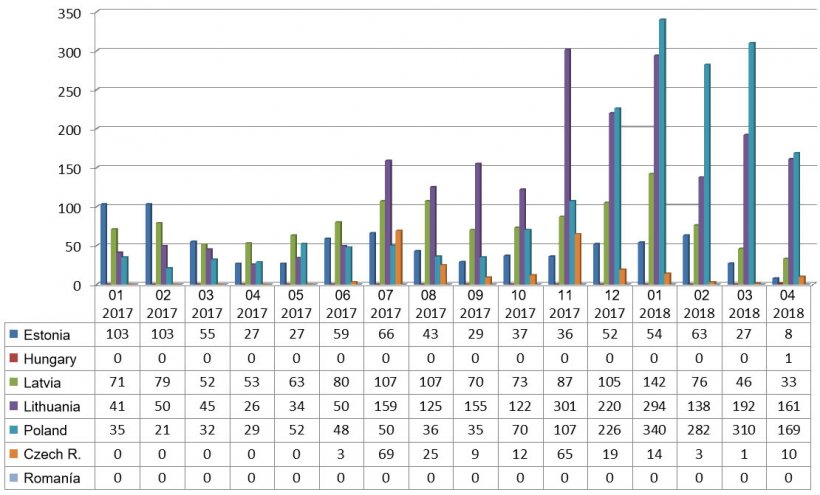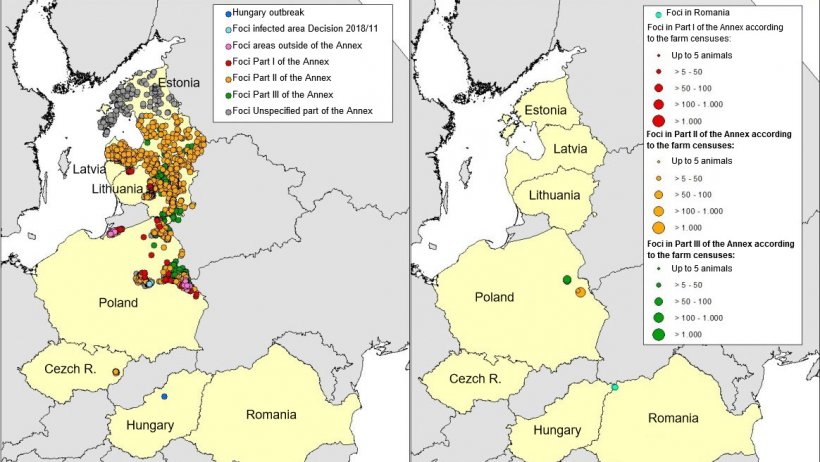African Swine Fever (ASF), a disease included in the list of urgent notifiable diseases, is undoubtedly one of the main health challenges for the European pig industry.
The disease has been present in the Italian island of Sardinia for more than 50 years, but undoubtedly, the greatest risk to the EU comes from the epidemiological situation in central and eastern Europe, where since its appearance in this area in 2014, its presence has been detected, either in domestic pigs or in wild boar, in 7 countries of the European Union: Lithuania, Latvia, Estonia, Poland, the Czech Republic, Romania and, recently, Hungary. In these countries, in 2017, a total of 124 outbreaks on pig farms and some 4,000 cases in wild boars were reported. In the first 4 months of 2018, 7 farms have been declared positive, but the virus was also detected in more than 2,400 wild boar, showing that during this period, the disease has been spreading and affecting new territories that were, until now, deemed free of the disease.


Monthly evolution of ASF foci in wild boar in 2017 and 2018 (until April 25th, 2018)

Map of ASF foci in wild boar (left) and domestic pigs (right) notified in Estonia, Latvia, Lithuania, Poland, Czech Republic and Romania in 2018 (until April 25th, 2018) (Source: RASVE-ADNS)
In this way, it is clear that, despite the great efforts that have been made, the disease has continued to spread slowly but continuously over the past few years in the wild boar populations, this being also linked to the transmission of the disease at greater distances, that has been associated to the human factor undoubtedly playing a critical role in these cases: e.g. littering with contaminated waste, such as food scraps, in places where wild boar have access or facilitating the contact of domestic pigs with such waste.
What can farmers and pig farm workers do to prevent the introduction of the disease in their country?
Bearing in mind that the most probable routes of transmission of ASF over long distances in the current epidemiological situation in Europe are related to the human factor (introduction of contaminated food scraps, use of clothing and footwear that have been in contact with infected material such as pig or wild boar faeces in affected countries, entry of undisinfected vehicles, etc.), it is necessary that farmers and pig farm workers are aware of the risk and that they adopt certain basic measures to reduce the risk of introducing the disease into their farm:
- Strict implementation of the necessary biosecurity measures to avoid the contact of domestic pigs with wildlife through infrastructures (fencing, etc.) and adequate management systems.
- Keep a strict control over the entry of vehicles and people into the farm and keep a record of them.
- Regarding visits to countries affected or at risk:
- Avoid, as far as possible, visits to the countryside and hunting. In case that these activities are carried out, clean and disinfect properly the clothes and footwear used before returning to your home country and avoid any contact with pig farms in these countries.
- Do not bring pork or wild boar meat products, especially if they are products outside the official commercial circuit without appropriate health controls.
- Do not feed the animals with food scraps under no circumstances.
It is essential to inform all personnel, including drivers, of this risk and of the biosecurity measures to be taken, especially to those who have the closest contact with the affected countries and also hunters (see the articles on Wild boar- Health risks).
What to do if I am facing an ASF suspicion on my farm?
If the disease enters a farm, the farmer, together with the veterinarian, play a critical role in its detection and early notification, that is key for achieving its rapid eradication and prevent its spreading to other farms. This role is critical in these moments of growing risk of entry of the disease.
The main symptoms that can make us suspect of the presence of ASF on our farm are: fever, lack of appetite and haemorrhagic lesions on the skin and internal organs, usually with high mortality rates in all age groups, although there are strains that produce a milder form, resulting in a more difficult clinical detection. In any case, it must be borne in mind that when the first clinical signs appear, the virus has already been on the farm for several days, so it is essential to notify immediately the veterinarian or the official veterinary services of any suspicion, however small it is.
The veterinarian will proceed to visit the farm to assess the situation and, if needed, take official samples from the animals for analysis in the laboratory to confirm or exclude the presence of the disease.
It is very important that from the very moment when the farmer or veterinarian has that suspicion (increase in deaths, animals with fever and presence of haemorrhages, etc.), the producer himself stops the movements of animals to avoid spreading the problem. In addition, it is necessary to implement strict biosecurity measures, avoiding any movement of people, animals, vehicles or any other element that may be contaminated from or into the farm, until the suspicion is discarded or confirmed.

Conclusions

We must always remember the importance of strengthening the biosecurity measures on pig farms, the appropriate conditions for the cleaning and disinfecting of the vehicles that transport pigs and other species, as well as the strict application of biosecurity measures by hunters who travel to go hunting, especially if they are going to countries affected or at risk of being affected by ASF.
On the other hand, we must emphasize the need for all farmers and veterinarians to maintain a standing alertness against the disease and that they inform the official veterinary services of any suspicion that they may encounter if they detect symptoms compatible with the disease in pigs or wild boar. This communication will undoubtedly help in the early detection of the disease if it enters the country and, therefore, to its rapid eradication.
Finally, I would like to highlight the risk that the movement of live animals and their products from the affected areas or at risk of being affected may pose, whether coming from domestic pigs or wild boar. Therefore the conditions established in the EU regulations must be strictly adhered to in all cases.
Prevention against ASF requires the collaboration of farmers, farm staff, veterinarians, drivers, hunters and official services. Together we can prevent the disease from reaching our country.





